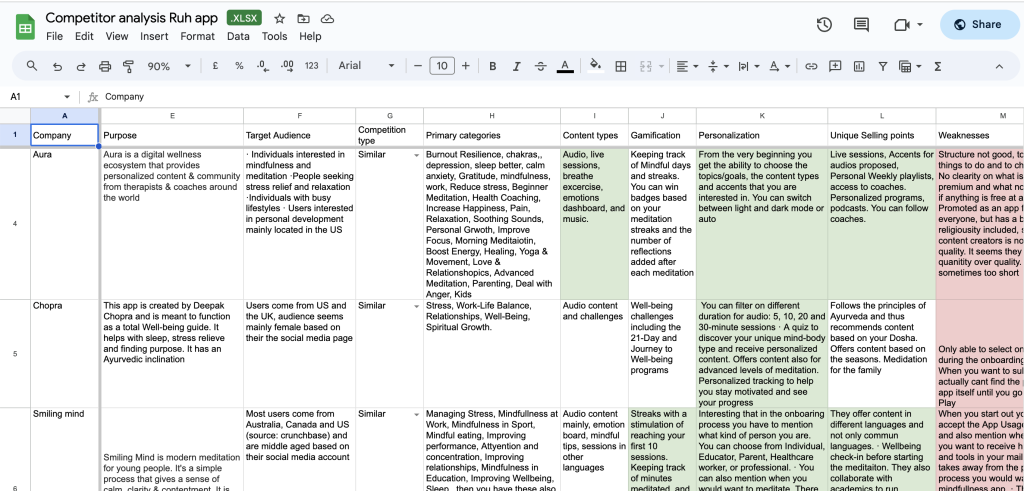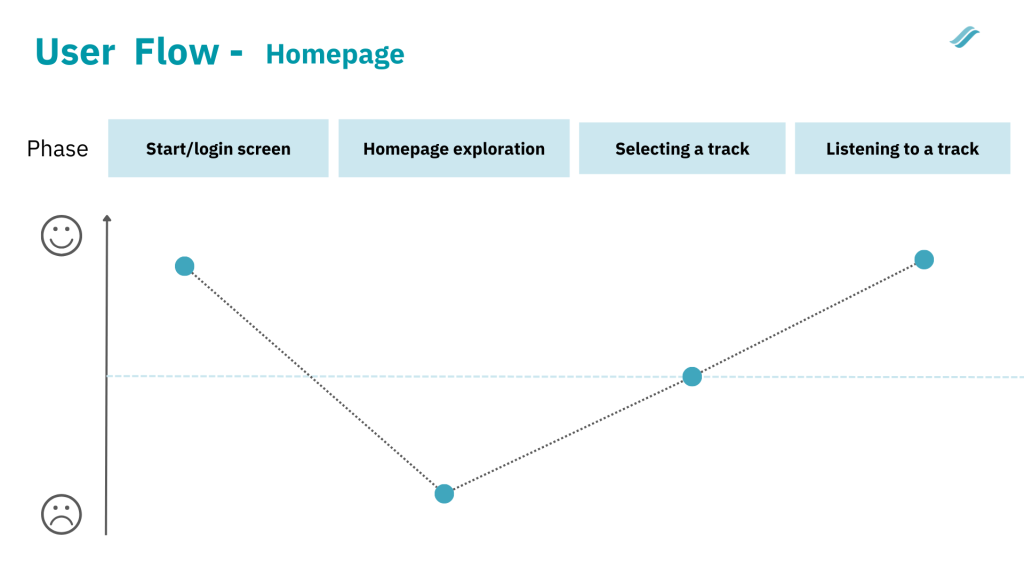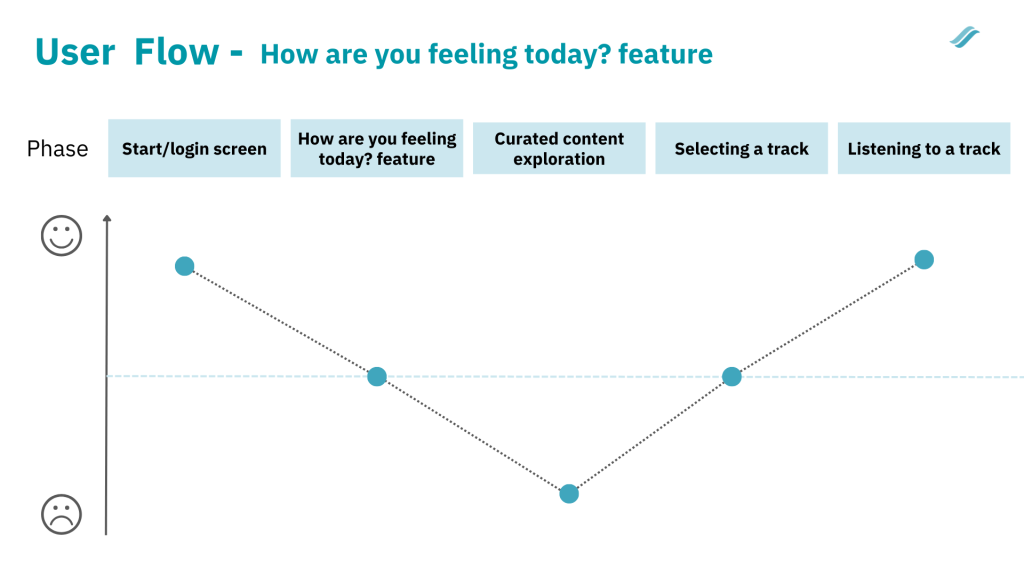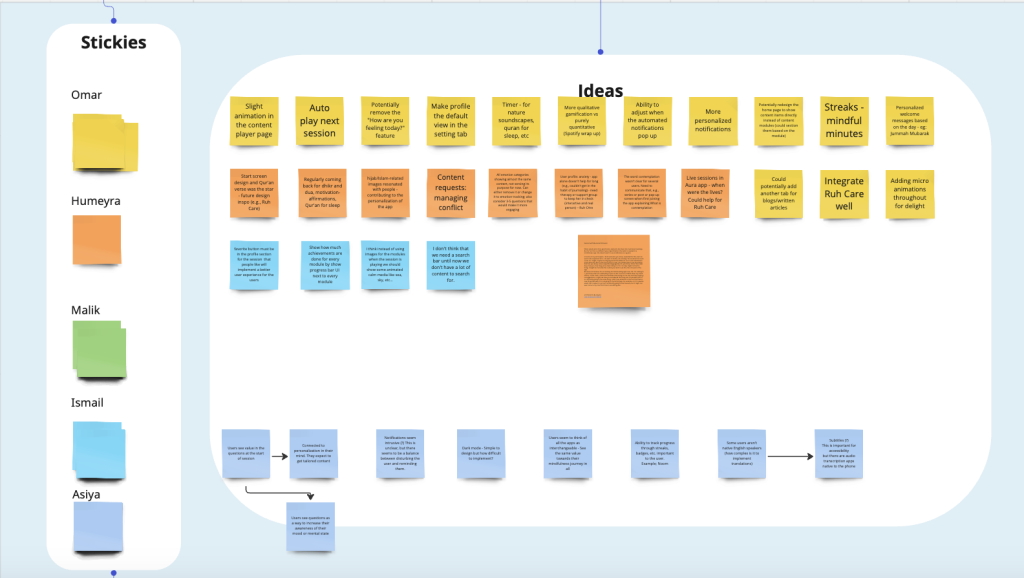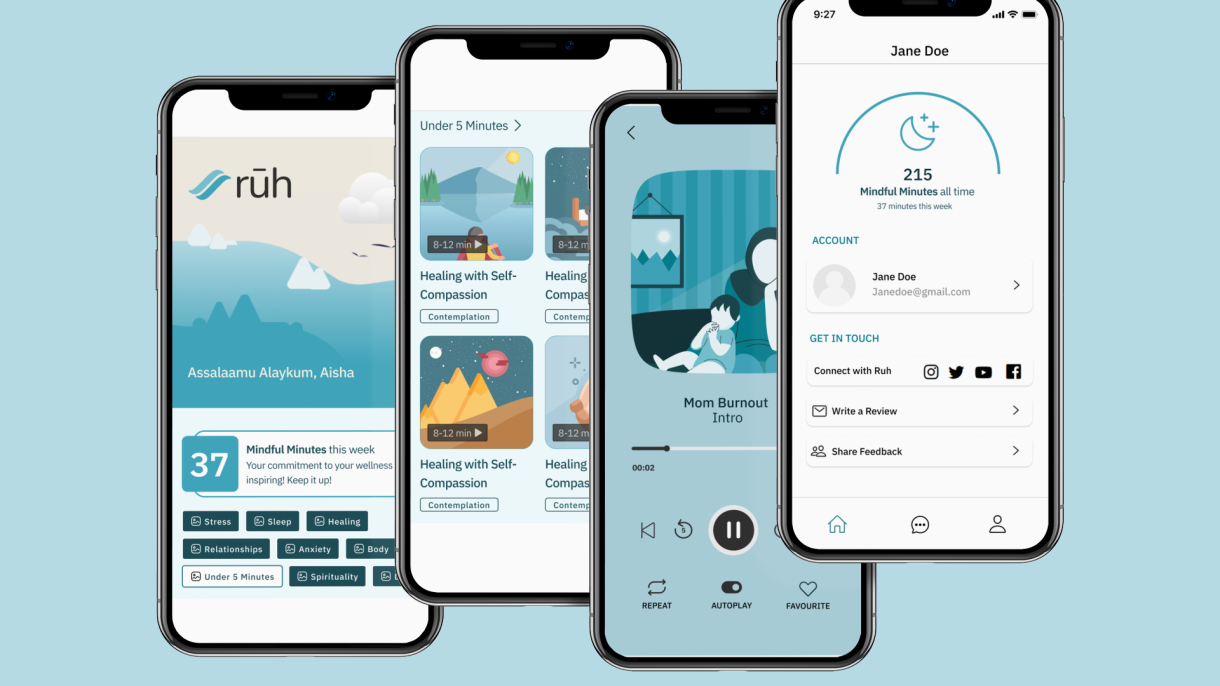
Ruh – The contemplation and meditation app for Muslims
- Client Ruh app
- My role UX researcher
- Team Hayate Ait Bouzid (UX researcher), Asiya Atcha (Product Designer), Ismael Al Saleh (Software Developer)
- Methods Stakeholder workshop, Competitive analysis, Usability test and Interviews
- Tools Miro, Betafi, Zoom, Figma
Investigating the Problem
Ruh app noticed a low retention and engagement for the past months and wanted to increase these numbers. They considered the lack of gamification, customization, and personalization on the app the cause. To uncover the root cause and formulate a research plan I led a stakeholder workshop We discussed potential causes of low retention and identified critical questions. This guided the research objectives. I also explored the team’s assumptions about gamification, customization, and personalization, gaining insights into their vision for these features. It’s worth noting that while the team focused on these areas, I kept an open mind to other potential causes.
Research Objective
Explore and implement different gamification methods, app customization and personalization to increase retention and the mental and faith-based value users can get from the app.
Crafting my Research Approach
Armed with this initial information, I broadened my scope to explore what other mindfulness and meditation apps were up to in this space. Doing this through a competitive analysis, I examined mindfulness and meditation apps, looking at both neutral and faith-based apps I also analyzed their user reviews for additional insights. The findings were compiled into a comparative matrix and then summarized (refer to the ‘all deliverables’ section). This approach helped determine if gamification, personalization, and customization were common competitive strategies among other meditation apps or whether other strategies were used.
Interviews & usability tests
After the competitor analysis it was crucial to validate certain aspects through direct conversations with actual users of meditation and mindfulness apps, together with understanding their perspectives on mindfulness practices and use of meditation and mindfulness apps. Participants tried both the Ruh app and a competitor app to compare experiences. I selected two competitor apps, including the advanced Balance app, known for its AI-driven personalization. Usability tasks spanned registration, personalization, navigating the home page, and practice selection. This meticulous approach provided thorough user insights.
I opted for these research methods due to the emerging nature of meditation and mindfulness in the Muslim community. To encourage open participation and engage a diverse, global audience, I avoided focus groups, which could be constrained by time zones and participants might be skeptical about opening up in front of others. Additionally, I did not perform a diary study as I didn’t require extensive insights into their mindfulness journeys. Given the project’s limited timeline, my focus was on understanding their current practices, past experiences with mindfulness or apps, and factors influencing continuity or discontinuation.
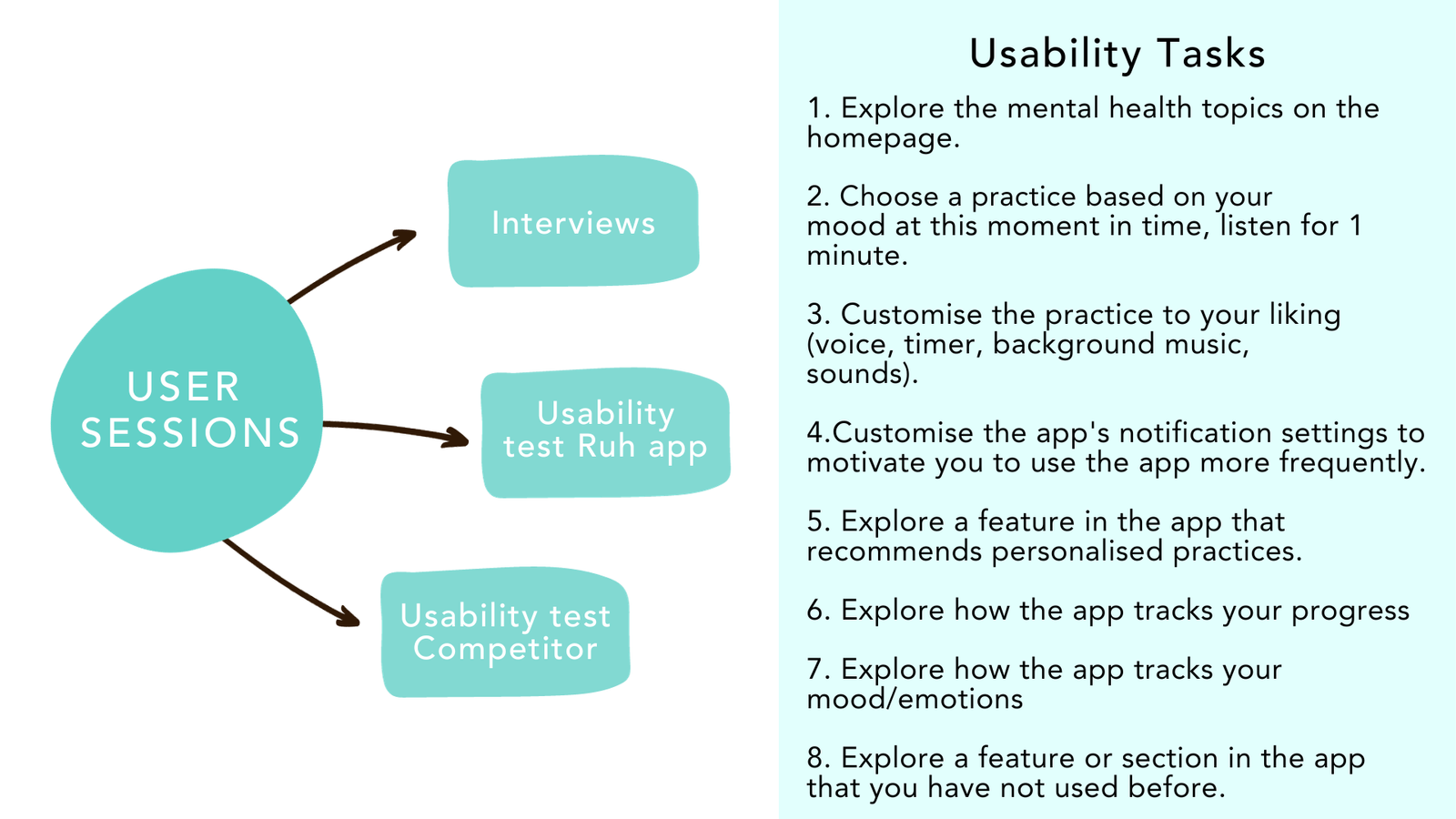 Participants
Participants
Recruitment for participants involved social media outreach to find individuals interested in mindfulness and meditation. I also created messages for the Ruh newsletter and their Instagram page, along with recording a video for their Instagram story. My target was 10 -12 participants, eventually I was able to recruit 9 participants. All participants underwent a screening process, meeting specific criteria:
- Age Range: 18-60 years
- Muslim
- Speaks English
- Interest in Mindfulness and/or personal growth
- Owns a smartphone
- Previous use of Mindfulness apps or tools (like journaling)
My analysis in images
To get access to the deliverables in detail, scroll down to the section ‘All deliverables ‘
From Obstacles to Opportunities
After conducting the interviews and usability tests, I analyzed all the transcriptions and notes. It was a manual process where I searched for patterns across the complete dataset. Later, I decided to bring the Ruh team for an affinity mapping workshop to uncover themes that could have been missed during the first analysis. Additionally, I created user journeys based on the two main ways a user could navigate through the app. This allowed me to analyze each step of the process in detail and see where the main hiccup is for the low retention numbers. This helped me identify three major blocks in the app.

Apart from that, during the data analysis process, I discovered many strengths that could be used by the Ruh team to emphasize more during their branding and marketing. These have also been communicated with the team.
In the next section, I go into the detailed insights and recommendations.
Detailed insights & recommendations
Participants need more content and feel overwhelmed with the current homepage structure
- Most participants observed a lack of content. The participants reasoned this by associating it with the immaturity and incompleteness of the app.
- The total duration of all tracks shown on the homepage was causing most participants to not want to click on a series.
- The content on the ‘all’ category on the homepage is experienced as ‘overwhelming’. Better categorization is needed.
- A few participants mentioned that the topics are not all encompassing.
Adding more clarity to the homepage will increase engagement with the content and app in general
Recommendations based on Ruh solely
Categorise the ‘all’ section of the homepage better, or show content that is relevant to the user by understanding their needs first (more on this later).
- Consider categorising content based on user needs/goals (e.g anxiety) – insight from competitor analysis.
- Be clear on what a contemplation is.
- Move away from showing total duration of series.
- Provide a basic Islamic meditation series, this is a low barrier introduction to the Ruh app, especially for users that are not sure if meditation and mindfulness are ‘Islamic’.
“Four tracks – 7 to 13 minutes, I think it would probably be beneficial to have that on the home screen or to indicate that it’s not 41 minutes. There are four different tracks because I wouldn’t have clicked on it otherwise, if you hadn’t prompted me” – Participant
”I think it just needs more content for it to be more helpful. The Balance app has more content and thus makes it worth paying for” – Participant
Participants want to feel that the app is interested in them & their needs
- Participant cannot adapt the session/tracks to their needs (e.g duration, voices
- The profile tab opens on the settings page
- The profile page is considered basic and is missing crucial elements of a profile page
- Favorite button and ‘create playlist’ function missing
- App doesn’t track usage of users to make the experience more personalised (e.g reminders based on past usage, needs or goals)
- A few liked the possibility to change the look and feel in the comparitive apps
Structure of the Profile and Settings page
In the full report I also gave recommendations around onboarding questionnaires in case it was desired to be added to the app.
“Again, more personalized questions. Like now that I know that there’s a profile, like all it has is my first name. Like that’s all it kind of knows about me. So again, like primary struggle why? Because people if they’re downloading these apps, especially mindfulness apps, they have a goal. (…) Ask more questions and you have almost a snapshot of the persons mental health at that moment. ” – Participant
Participants find pleasure in tracking their progress and striving towards a meaningful goal, as well as feeling valued for their efforts.
- Some participants disliked the idea of badges because they give a ‘childish’ value to mindfulness.
- Some participants didn’t understand the concept of levels (Aura app) within mindfulness and meditation.
- One participant mentioned that gamification should not make an anxious person feel bad about their progress.
- A few participants were keen on knowing what skills and tools they are learning from a session to make sure they can take it with them in their daily life.
Recommendations – Gamification
- Allow users to track their progress
- Badges didn’t score well during the tests, visually moving towards a specific goal would be more helpful*
- Consider adding value by being clear about the skills a user is gaining from a specific session (e.g less reactiveness, body awareness).
- Bring the goal screen when registering to all entry points and make it editable from the profile page
*Could have been different with an equal gender ratio among participants.
Recommendations – Notifications
- Appreciative notifications are considered a motivation and stimulate to visit the app
- Direct example wording for notifications given by participants:
- ”You’ve been using the app for an entire week, we’re happy to have you in our family for a whole week” – Participant
- ”You listened to self compassion today, have you found yourself practicing it?” – Participant
Participants like aesthetically pleasing designs that show app maturity and set the participants in the right mood
- One participant wished the design to be more sophisticated. Words like ‘childish’, ‘cartoony ‘ and ‘immature’ have been mentioned.
- Within the sessions some participants mentioned that the images are too basic or don’t represent the topic of the session well
- A few participants mentioned that they really liked the animation and transitions from the comparative apps, this is missing in the Ruh app
Recommendations – Design
- Revise the designs of the series images (the images above the introduction of a session, need the most attention).
- Consider looking into the type of graphic design used currently, to avoid it being identified as childish, immature.
- Consider adding more animation when interacting with a session/track. They set participants in the right mood before starting or when completing a session (this was also mentioned in the affinity mapping session).
- Consider updating the design of the player, it is currently considered as basic by some participants (elements as favourite button, ‘add to playlist’ feature can also be a great addition).
- Consider adding a dark-mode, especially for the player.
My Research Reflection
This research held a personal significance for me in various ways. It enabled me to gain a deeper understanding of the users, particularly as someone who shares an interest in mindfulness and practices meditation as a Muslim. This connection allowed me to empathize with their needs and concerns. Nevertheless, it’s important to acknowledge that this closeness could have potentially led me to overlook subtle factors that might have influenced my analysis.
During the participant recruitment process, there were some delays on the client’s end, resulting in a smaller sample size of 9 participants. Additionally, the uneven gender distribution may have had an impact on the data outcomes, particularly in relation to badge preferences. The research findings revealed that of the participants (N=9), all 7 females were not in favor of badges as part of gamification on the app, whereas all 2 males were in favor. Therefore, in relative terms, the majority expressed a lack of preference for them. This information was explicitly outlined in the report, along with the acknowledgment that an even gender distribution could potentially yield different outcomes regarding badge preferences.
All deliverables
- Research plan
- User journey (homepage)
- User journey (how are you feeling today?)
- Affinity mapping workshop outcome
- User personas (visible under ‘My analysis in images’)
- Competitor analysis summary
- Competitor analysis matrix
